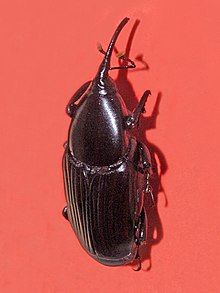| African Palm Weevil | |
|---|---|

| |
| Museum specimen of Rhynchophorus phoenicis | |
| Scientific classification | |
| Domain: | Eukaryota |
| Kingdom: | Animalia |
| Phylum: | Arthropoda |
| Class: | Insecta |
| Order: | Coleoptera |
| Suborder: | Polyphaga |
| Infraorder: | Cucujiformia |
| Family: | Curculionidae |
| Genus: | Rhynchophorus |
| Species: | R. phoenicis |
| Binomial name | |
| Rhynchophorus phoenicis (Fabricius, 1801) | |
| Synonyms | |
| |
The African Palm Weevil or Rhynchophorus phoenicis is a species of beetles belonging to the family Curculionidae.
Varieties
- Rhynchophorus phoenicis var. niger Faust, 1899
- Rhynchophorus phoenicis var. ruber Faust, 1899
Description
African Palm Beetles can reach a body length of about 25 mm. These large beetles are considered a serious pest in palm plantations, particularly damaging young palms, mainly Cocos nucifera, Metroxylon sagu, Raphia species, Elaeis guineensis and Phoenix dactylifera.
The life cycle of the African Palm Weevil is similar to that of other Rhynchophorus species. The adults lay eggs in wounds in the stems of dying or damaged parts of palms. After hatching, the weevil larvae excavate tunnels in the trunk and feed on the shoot and young leaves, frequently leading to the death the host plants. The larvae of this palm weevil are edible.
Distribution
The species is widespread throughout tropical and equatorial Africa, from Senegal to Ethiopia, Nigeria and South Africa.
References
- Biolib
- Encyclopaedia of Life
- Plantwise
- James TANYI TAMBE1, Paola RIOLO, Justin Nambangi OKOLLE, Nunzio ISIDORO, Pietro Paolo FANCIULLI, Romano DALLAI Sexual size differences and colour polymorphism of Rhynchophorus phoenicis in the Southwest region of Cameroon
| Taxon identifiers | |
|---|---|
| Rhynchophorus phoenicis | |
This Dryophthorinae-related article is a stub. You can help Misplaced Pages by expanding it. |